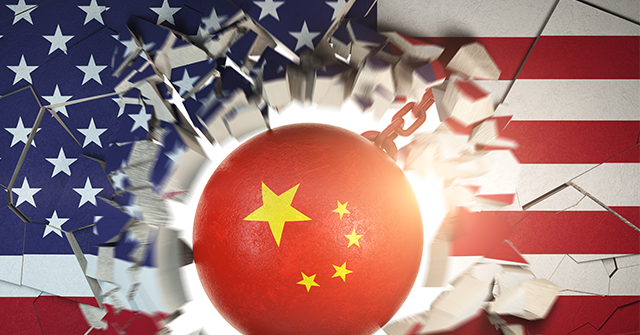Nobel Prize Vindicates Economic Nationalism, Part II: Why China’s Theft Kills Innovation
In Monday’s Breitbart Business Digest, we examined how Joel Mokyr’s Nobel Prize-winning research shows that political fragmentation and sovereignty drive innovation. Today: Philippe Aghion and Peter Howitt’s theory of creative destruction—and why China’s systematic IP theft violates the core conditions their model requires for innovation to flourish.
Their groundbreaking 1992 model explains with mathematical precision how innovation creates self-perpetuating growth. But it also reveals a devastating vulnerability: the framework depends on innovators capturing returns from their breakthroughs. China’s intellectual property theft destroys that mechanism.
The Theory of Creative Destruction
Philippe Aghion and Peter Howitt’s 1992 paper transformed economics by providing the first rigorous mathematical model of how Schumpeter’s “creative destruction” generates sustained growth.
Their framework shows how innovation creates a self-perpetuating cycle. Entrepreneurs invest in research to create products that make existing ones obsolete. Each innovation generates temporary monopoly profits that motivate the next round of innovation. New technologies replace old ones, productivity rises, and living standards improve.
This wasn’t just abstract theory. Aghion and Howitt explained why modern economies experience sustained progress over decades rather than temporary booms followed by stagnation, answering one of the most fundamental questions in economics.
The model has a crucial requirement: innovators must capture enough value to justify risky and expensive R&D investments. Without adequate returns, the innovation cycle breaks down.
The Inverted-U: Why Market Power Matters
Aghion and Howitt also discovered an “inverted-U” relationship between competition and innovation that has profound implications for both antitrust and trade policy.
Too little competition breeds complacency. Monopolists facing no threats simply extract rents from their existing market position. But too much competition also discourages innovation. Perfect competition means zero economic profits—and zero incentive for costly innovation.
The sweet spot is moderate competition where firms feel pressure to innovate to escape their rivals, but can still earn returns that make innovation worthwhile. Firms need temporary market power to recoup their R&D investments.
This reveals why intellectual property protection matters for growth. Patents and trade secrets give innovators that temporary market power. Without IP protection, firms slide to the right side of the inverted U—too much competition, too little ability to capture returns, and innovation collapses.
China’s IP Theft Breaks the Innovation Cycle
China doesn’t just occasionally tolerate IP theft—it is core to their economic model. They require foreign companies to form joint ventures and transfer technology as the price of market access. They engage in cyber espionage to steal trade secrets. They encourage domestic firms to reverse-engineer foreign innovations.
When American firms invest millions in developing new technologies only to have China steal the IP and produce knockoffs, the expected returns from innovation collapse. The firm bears all the development risk and cost, but captures only a fraction of the returns.
In Aghion-Howitt terms, China pushes American innovators to the right side of the inverted-U—where competition is so intense that innovation becomes economically irrational.
The Rare Earths Disaster
America’s rare earths disaster illustrates exactly how this destroys innovation capacity.
U.S. companies pioneered rare earth processing technologies through expensive R&D. These elements are critical for everything from smartphones to missiles to wind turbines. American firms led the world in both extraction and processing.
China then implemented a multi-pronged strategy: subsidize production far below cost, acquire American technical knowledge, drive U.S. producers out of business, and achieve near-monopoly control. Then they restricted exports and raised prices.
The result wasn’t just lost jobs—it was lost innovation capacity in a critical technology sector. Today, America depends on China for rare earth supplies vital to both commercial products and defense systems. The engineers with expertise retired or moved to other fields. The institutional knowledge disappeared. The supply chains dissolved.
This is the opposite of creative destruction. It’s pure destruction of both current production and future innovation capacity.
Beyond Rare Earths
The pattern repeats across industries. Solar panels, where American innovations in photovoltaic technology gave way to Chinese manufacturing dominance through forced technology transfer. Steel, where massive subsidies destroyed productive capacity worldwide. Telecommunications, where Huawei built capabilities partly through systematic acquisition of Western technology.
The conventional economic view treated this as normal trade: China has lower costs, comparative advantage dictates that they should produce these goods, and everyone benefits. But this misses what the Aghion-Howitt model makes clear: you’re destroying the innovation cycle itself.
When American firms can’t capture returns from innovation in a sector, they stop innovating in that sector. Once lost, that capacity is extraordinarily difficult to rebuild.
The Aghion-Howitt model provides the reframing: free trade with a country that systematically steals intellectual property isn’t free trade. It’s a system that transfers innovation costs to one party while allowing the other to capture the benefits.
True free trade requires protection of property rights, including intellectual property. When China steals IP, they violate the fundamental prerequisite for mutually beneficial trade.
Tariffs and restrictions on technology transfer aren’t protectionism. They’re enforcing the property rights protection that makes innovation possible. Without such protection, American firms face an impossible choice: stop innovating in fields where China can copy the technology, or bear all R&D costs while capturing only a fraction of returns.
Neither sustains the innovation cycle that drives growth.
Tomorrow: Offshoring vs. Innovation
Tomorrow we’ll examine Aghion’s later empirical research showing why job losses from offshoring differ fundamentally from job losses due to domestic innovation. But today’s argument stands alone.
The Aghion-Howitt theory won the Nobel Prize for explaining how innovation drives sustained growth. That same theory reveals why trade with China—conducted under rules of systematic IP theft—destroys the conditions necessary for innovation to flourish.
China isn’t competing on efficiency. It’s free-riding on American innovation while destroying American incentives to innovate. Protecting intellectual property isn’t protectionism. It’s preserving the mechanism that makes innovation possible.
Read the full article here
